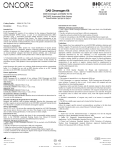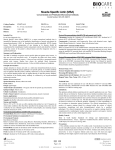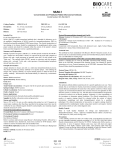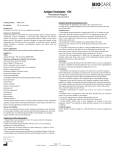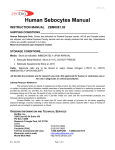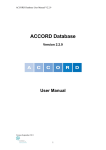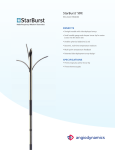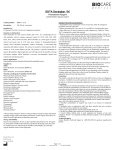Download Data Sheet
Transcript
Uroplakin II Concentrated and Prediluted Monoclonal Antibody Control Number: 901-3051-032415 Catalog Number: ACI 3051 A, C API 3051 AA OAI 3051 T60 Description: 0.1, 1.0 ml, concentrated 6.0 ml, prediluted 60 tests, prediluted Dilution: 1:50-1:100 Ready-to-use Ready-to-use Diluent: Van Gogh Yellow N/A N/A ISO 9001&13485 CERTIFIED Intended Use: For In Vitro Diagnostic Use. Uroplakin II [BC21] is a mouse monoclonal antibody that is intended for laboratory use in the qualitative identification of uroplakin II protein by immunohistochemistry (IHC) in formalin-fixed paraffin-embedded (FFPE) human tissues. The clinical interpretation of any staining or its absence should be complemented by morphological studies using proper controls and should be evaluated within the context of the patient’s clinical history and other diagnostic tests by a qualified pathologist. Protocol Recommendations Cont'd: Polymer: Incubate for 10 minutes at RT with a tertiary polymer. Chromogen: Incubate for 5 minutes at RT with Biocare’s DAB – OR – Incubate for 5-7 minutes at RT with Biocare’s Warp Red. Counterstain: Counterstain with hematoxylin. Rinse with deionized water. Apply Tacha's Bluing Solution for 1 minute. Rinse with deionized water. Summary and Explanation: Uroplakin II is a 15 kDa protein component of urothelial plaques, which enhance the permeability barrier of the urothelium (1). Studies have shown Uroplakin II mRNA was expressed in bladder cancer tissues and peripheral blood of patients with primary and metastatic urothelial carcinoma of the bladder (2-4). A new mouse monoclonal Uroplakin II antibody [BC21] was developed and exhibited an increased staining sensitivity (46/59, 78%) when compared to Uroplakin III [AU1] (19/56, 34%) in cases of urothelial carcinoma of the bladder (see Performance Characteristics). With the exception of bladder and ureter, Uroplakin II [BC21] was found to be highly specific when evaluated in various normal and neoplastic tissues, including prostate cancer and renal cell carcinoma (see Performance Characteristics). Uroplakin II [BC21] is a highly specific antibody that may be useful in identifying tumors of urothelial origin. PATENT PENDING. Technical Note: This antibody has been standardized with Biocare's MACH 4 detection system. It can also be used on an automated staining system and with other Biocare polymer detection kits. Use TBS buffer for washing steps. Protocol Recommendations (ONCORE Automated Slide Staining System): OAI3051 is intended for use with the ONCORE Automated Slide Staining System. Refer to the ONCORE Automated Slide Staining System User Manual for specific instructions on its use. Protocol parameters in the ONCORE Automated Slide Stainer Protocol Editor should be programmed as follows: Principle of Procedure: Antigen detection in tissues and cells is a multi-step immunohistochemical process. The initial step binds the primary antibody to its specific epitope. A secondary antibody may be applied to bind the primary antibody, followed by an enzyme labeled polymer; or an enzyme labeled polymer may be applied directly to bind the primary antibody. The detection of the bound primary antibody is evidenced by an enzyme-mediated colorimetric reaction. Source: Mouse monoclonal Species Reactivity: Human; others not tested Clone: BC21 Isotype: IgG1/kappa Total Protein Concentration: ~10 mg/ml. Call for lot specific Ig concentration Epitope/Antigen: Residues 36-50 of human Uroplakin II Cellular Localization: Cytoplasmic and membrane Positive Tissue Control: Normal bladder or urothelial carcinoma of the bladder Known Applications: Immunohistochemistry (formalin-fixed paraffin-embedded tissues) Supplied As: Buffer with protein carrier and preservative Storage and Stability: Store at 2ºC to 8ºC. Do not use after expiration date printed on vial. If reagents are stored under conditions other than those specified in the package insert, they must be verified by the user. Diluted reagents should be used promptly; any remaining reagent should be stored at 2ºC to 8ºC. Protocol Recommendations: Peroxide Block: Block for 5 minutes with Biocare's Peroxidazed 1. Pretreatment: Perform heat retrieval using Biocare’s Reveal Decloaker. Refer to the Reveal Decloaker product data sheet for specific instructions. Protein Block (Optional): Incubate for 5-10 minutes at RT with Biocare's Background Punisher. Primary Antibody: Incubate for 30 minutes at RT. Probe: Incubate for 10 minutes at RT with a secondary probe. Protocol Name: Uroplakin II Protocol Template (Description): Ms HRP Template 1 Dewaxing (DS Option): DS2 Antigen Retrieval (AR Option): AR2, low pH; 101°C Reagent Name, Time, Temp.: Uroplakin II, 30 min., 25°C Performance Characteristics: Sensitivity and specificity testing of Uroplakin II [BC21] was performed by staining with MACH 4 Universal HRP-Polymer Detection. See Tables 1 and 2 for expected results. Limitations: The optimum antibody dilution and protocols for a specific application can vary. These include, but are not limited to: fixation, heat-retrieval method, incubation times, tissue section thickness and detection kit used. Due to the superior sensitivity of these unique reagents, the recommended incubation times and titers listed are not applicable to other detection systems, as results may vary. The data sheet recommendations and protocols are based on exclusive use of Biocare products. Ultimately, it is the responsibility of the investigator to determine optimal conditions. The clinical interpretation of any positive or negative staining should be evaluated within the context of clinical presentation, morphology and other histopathological criteria by a qualified pathologist. The clinical interpretation of any positive or negative staining should be complemented by morphological studies using proper positive and negative internal and external controls as well as other diagnostic tests. Quality Control: Refer to CLSI Quality Standards for Design and Implementation of Immunohistochemistry Assays; Approved Guideline-Second edition (I/LA28-A2) CLSI Wayne, PA USA (www.clsi.org). 2011 Precautions: 1. This antibody contains less than 0.1% sodium azide. Concentrations less than 0.1% are not reportable hazardous materials according to U.S. 29 CFR 1910.1200, OSHA Hazard communication and EC Directive 91/155/EC. Sodium azide (NaN3) used as a preservative is toxic if ingested. Sodium azide may react with lead and copper plumbing to form highly explosive metal azides. Upon disposal, flush with large volumes of water to prevent azide build-up in plumbing. (Center for Disease Control, 1976, National Institute of Occupational Safety and Health, 1976) (5) Page 1 of 2 Uroplakin II Concentrated and Prediluted Monoclonal Antibody Control Number: 901-3051-032415 Precautions Cont'd: 2. Specimens, before and after fixation, and all materials exposed to them should be handled as if capable of transmitting infection and disposed of with proper precautions. Never pipette reagents by mouth and avoid contacting the skin and mucous membranes with reagents and specimens. If reagents or specimens come in contact with sensitive areas, wash with copious amounts of water. (6) 3. Microbial contamination of reagents may result in an increase in nonspecific staining. 4. Incubation times or temperatures other than those specified may give erroneous results. The user must validate any such change. 5. Do not use reagent after the expiration date printed on the vial. 6. The SDS is available upon request and is located at http://biocare.net/. Troubleshooting: Follow the antibody specific protocol recommendations according to data sheet provided. If atypical results occur, contact Biocare's Technical Support at 1-800-542-2002. References: 1. Wu XR, et al. Uroplakins in urothelial biology, function, and disease. Kidney Int. 2009 Jun; 75(11):1153-65. 2. Wu X, et al. Uroplakin II as a promising marker for molecular diagnosis of nodal metastases from bladder cancer: comparison with cytokeratin 20. J Urol. 2005 Dec; 174(6):2138-42. 3. Lu JJ, et al. Detection of circulating cancer cells by reverse transcription-polymerase chain reaction for uroplakin II in peripheral blood of patients with urothelial cancer. Clin Cancer Res. 2000 Aug; 6(8):3166-71. 4. Li SM, et al. Detection of circulating uroplakin-positive cells in patients with transitional cell carcinoma of the bladder. J Urol. 1999 Sep; 162(3 Pt 1):931-5. 5. Center for Disease Control Manual. Guide: Safety Management, NO. CDC-22, Atlanta, GA. April 30, 1976 "Decontamination of Laboratory Sink Drains to Remove Azide Salts." 6. Clinical and Laboratory Standards Institute (CLSI). Protection of Laboratory Workers from Occupationally Acquired Infections; Approved Guideline-Fourth Edition CLSI document M29-A4 Wayne, PA 2014. Table 1: Sensitivity of mouse monoclonal antibody Uroplakin II [BC21] was determined by testing formalin-fixed, paraffin-embedded neoplastic tissues. Tissue Types Number Positive/Number of Cases Bladder cancer 46/59* Prostate cancer 1/88** Lung cancer 0/20 Kidney cancer (various phenotypes) 3/75*** Colon cancer 0/63 Brain cancer 0/13 Lymphoma 0/25 Melanoma 0/19 Ovarian cancer 0/11 Seminoma 0/14 Breast cancer 0/74 Adrenal gland cancer 0/2 Thyroid cancer 0/2 Pancreas cancer (various phenotypes) 0/10 Head & neck cancer (various phenotypes) 0/10 Soft tissue cancer (various phenotypes) 0/10 Liver cancer (various phenotype) 0/10 Cervix cancer (various phenotypes) 0/10 ISO 9001&13485 CERTIFIED Table 2: Specificity of mouse monoclonal antibody Uroplakin II [BC21] was determined by testing formalin-fixed, paraffin-embedded normal tissues. Tissue Adrenal gland Bladder Bone marrow Eye Breast Cerebellum Cerebral cortex Fallopian tube GI-Esophagus GI-Stomach GI-Small intestine GI-Colon GI-Rectum Heart Kidney Liver Lung Ovary Pancreas Parathyroid Pituitary gland Placenta Prostate Skin Spinal cord Spleen Striated muscle Testis Thymus Thyroid Tonsil Ureter Uterus-cervix Uterus-endometrium Tongue Epiglottis Blood vessel and adipose tissue * For comparison, Uroplakin III [Clone AU1] stained 19/56 cases of bladder cancer. ** 1 positive case, which may be metastatic bladder cancer that has spread to prostate *** 3 positive cases, which are transitional cell carcinomas from upper ureters Page 2 of 2 Number Positive/ Total Tissues 0/3 5/7 0/1 0/2 0/3 0/3 0/3 0/3 0/3 0/3 0/3 0/3 0/3 0/3 0/16 0/5 0/3 0/3 0/5 0/1 0/2 0/3 0/5 0/2 0/2 0/2 0/4 0/3 0/3 0/4 0/3 3/3 0/3 0/3 0/1 0/1 0/1


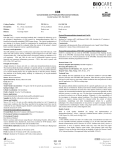

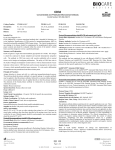
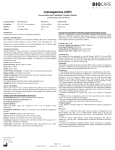
![Progesterone Receptor (PR) [16]](http://vs1.manualzilla.com/store/data/005703733_1-5d4a6a4c070c4aacc906912b3410a27a-150x150.png)
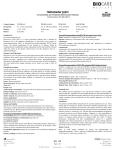
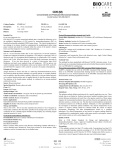
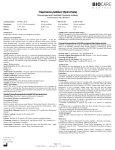
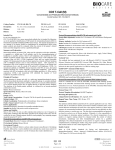
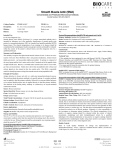
![TTF-1 [SPT24] - Zytomed Systems](http://vs1.manualzilla.com/store/data/005793963_1-173a06c06d5648223f763723a0e98383-150x150.png)
